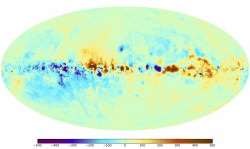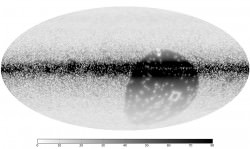[/caption]
Kudos to the scientists at the Max Planck Institut and an international team of radio astronomers for an incredibly detailed new map of our galaxy’s magnetic fields! This unique all-sky map has surpassed its predecessors and is giving us insight into the magnetic field structure of the Milky Way beyond anything so far seen. What’s so special about this one? It’s showing us a quality known as Faraday depth – a concept which works along a specific line of sight. To construct the map, data was melded from 41,000 measurements collected from a new image reconstruction technique. We can now see not only the major structure of galactic fields, but less obvious features like turbulence in galactic gas.
So, exactly what does a new map of this kind mean? All galaxies possess magnetic fields, but their source is a mystery. As of now, we can only guess they occur due to dynamo processes… where mechanical energy is transformed into magnetic energy. This type of creation is perfectly normal and happens here on Earth, the Sun, and even on a smaller scale like a hand-crank powered radio – or a Faraday flashlight! By showing us where magnetic field structures occur in the Milky Way, we can get a better understanding of galactic dynamos.

Although that sounds like a wealth of information, it’s still not really enough. There are huge areas, particularly in the southern sky, where only a few measurements exist. Because of this lack of data, we have to interpolate between existing data points and that creates its own problems. First, the accuracy varies and more precise measurements should help. Also, astronomers are not exactly sure of how reliable a single measurement can be – they just have to take their best guess based on what information they have. Still, other problems exist. There are measurement uncertainties due to the complex nature of the process. A small error can increase by tenfold and this could convolute the map if not corrected. To help fix these problems, scientists at MPA developed a new algorithm for image capture, named the “extended critical filter”. In its creation, the team utilizes tools provided by the new discipline known as information field theory – a powerful tool that blends logical and statistical methods to applied fields and stacks it up against inaccurate information. This new work is exciting because it can also be applied to other imaging and signal-processing venues in alternate scientific fields.

The good news is the galactic dynamo theory seems to be spot on. It has predicted symmetrical structures and the new map reflects it. In this projection, the magnetic fields are lined up parallel to the plane of the galactic disc in a spiral. This direction is opposite above and below the disc and the observed symmetries in the Faraday map arise from our location within the galactic disc. Here we see both large and small structures tied in with the turbulent, dynamic Milky Way gas structures. This new map algorithm has a great side-line, too… it characterizes the size distribution of these structures. Larger ones are more definitive than smaller ones, which is normal for turbulent systems. This spectrum can then be stacked against computer models of dynamics – allowing for intricate testing of the galactic dynamo models.
This incredible new map is more than just another pretty face in astronomy. By providing information of extragalactic magnetic fields, we’re enabling radio telescope projects such as LOFAR, eVLA, ASKAP, Meerkat and the SKA to rise to new heights. With this will come even more updates to the Faraday Sky and reveal the mystery of the origin of galactic magnetic fields.
Original Story Source: Max Planck Institut for Astrophysics News Release. For Further Reading: An improved map of the galactic Faraday sky”. Download the map HERE.


So I killed ads and it looks better. It even killed white holes. I use abine, easylist and personal list on IE9. I’d also very much like to kill swinburn astronomy pic and another pop-up you might not enjoy. 😀 Any ideas? Also, I have 15” LCD, left-right scrolling sucks. It’s too wide.
Hm. Firefox and AdBlock Plus. 😉
Opera FTW!
Seriously IE? What does your Mom use then? It’s beyond my imagination.
PS. How about unbanning EU, just for this topic, so we can have (maybe) some nice dispute here on this interesting topic (well, at least it’s gonna be fun).
Mom doesn’t have a computer. 😀
I have Chrome as well, but I use it only for zooniverse hunting. I added ABP and ScriptNo and killed both things I wanted. I hope I can do it in IE9.
Then there is scrolling left right, I guess I could use magnifying glass, but I’d have to make a text bigger…
What’s the ballpark strength of this field, Tammy? (Gauss or teslas will do)
The magnetic field strengths in the Milky Way and most other galaxies that we know something about the magnetic fields in are of order micro-Gauss.
Hi Tammy,
Great article. I’m actually involved in work on Faraday Rotation measures of magnetism, mainly in distant galaxies. The upcoming surveys such as POSSUM (Polarisation Sky Survey of the Universe’s Magnetism) on ASKAP are going to derive the Rotation Measure towards over 3 million extragalactic objects in the next few years. These spectropolarimetric surveys are going to blow our current understanding of magnetism in the Milky Way, as well as magnetic fields throughout the universe, completely out of the water. It is a very exciting time in this field!
Thanks for the article. Really enjoyed it.
I am SO glad I didn’t miss this article! I can’t wait to see higher resolution images! WOW! Magnetic field shift up/down and left/right eh? I can understand the N/S up/down polarity shift as a bi polar mag. field effect? And perhaps the left/right polarity as an edge on rotational effect?
Rotating opposing polarity or chiral Matter/Energy fountains at Brane junctions anyone? THAT would go a LONG way into explaining the shape of spiral galaxies if the dust plane is created as the result of matter/antimatter or mirror matter annihilation in the rotating neutral equatorial disk?